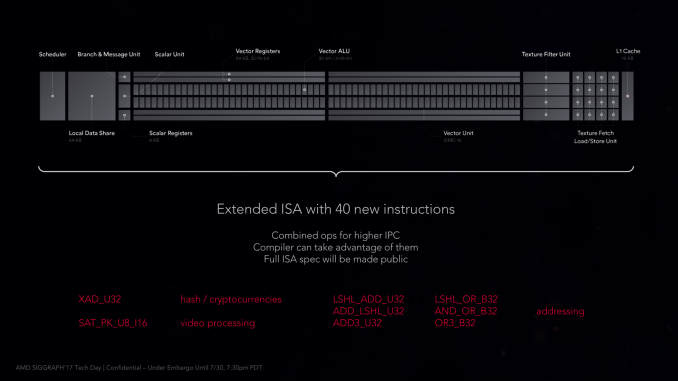The AMD Radeon RX Vega 64 & RX Vega 56 Review: Vega Burning Bright
by Ryan Smith & Nate Oh on August 14, 2017 9:00 AM ESTThe Vega Architecture: AMD’s Brightest Day
From an architectural standpoint, AMD’s engineers consider the Vega architecture to be their most sweeping architectural change in five years. And looking over everything that has been added to the architecture, it’s easy to see why. In terms of core graphics/compute features, Vega introduces more than any other iteration of GCN before it.
Speaking of GCN, before getting too deep here, it’s interesting to note that at least publicly, AMD is shying away from the Graphics Core Next name. GCN doesn’t appear anywhere in AMD’s whitepaper, while in programmers’ documents such as the shader ISA, the name is still present. But at least for the purposes of public discussion, rather than using the term GCN 5, AMD is consistently calling it the Vega architecture. Though make no mistake, this is still very much GCN, so AMD’s basic GPU execution model remains.
So what does Vega bring to the table? Back in January we got what has turned out to be a fairly extensive high-level overview of Vega’s main architectural improvements. In a nutshell, Vega is:
- Higher clocks
- Double rate FP16 math (Rapid Packed Math)
- HBM2
- New memory page management for the high-bandwidth cache controller
- Tiled rasterization (Draw Stream Binning Rasterizer)
- Increased ROP efficiency via L2 cache
- Improved geometry engine
- Primitive shading for even faster triangle culling
- Direct3D feature level 12_1 graphics features
- Improved display controllers
The interesting thing is that even with this significant number of changes, the Vega ISA is not a complete departure from the GCN4 ISA. AMD has added a number of new instructions – mostly for FP16 operations – along with some additional instructions that they expect to improve performance for video processing and some 8-bit integer operations, but nothing that radically upends Vega from earlier ISAs. So in terms of compute, Vega is still very comparable to Polaris and Fiji in terms of how data moves through the GPU.
Consequently, the burning question I think many will ask is if the effective compute IPC is significantly higher than Fiji, and the answer is no. AMD has actually taken significant pains to keep the throughput latency of a CU at 4 cycles (4 stages deep), however strictly speaking, existing code isn’t going to run any faster on Vega than earlier architectures. In order to wring the most out of Vega’s new CUs, you need to take advantage of the new compute features. Note that this doesn’t mean that compilers can’t take advantage of them on their own, but especially with the datatype matters, it’s important that code be designed for lower precision datatypes to begin with.











213 Comments
View All Comments
Oxford Guy - Monday, August 14, 2017 - link
This may be more of a shortcoming in the GloFo process than in the design of the chip. It would be very interesting to see how well it would do in PPW on TSMC's process.Exodite - Wednesday, August 16, 2017 - link
Of course, I were talking about the noise. :)The power consumption is, as I mentioned, a disappointment.
I'd be interested in seeing how the cards do with undervolting and other tweaks, the 480 actually gained performance in some situations due to the lower power draw resulting in more headroom.
Oxford Guy - Monday, August 14, 2017 - link
A vapor chamber is hardly "terrible" in terms of quality. But a high power draw + a blower = physics of noise.Oxford Guy - Monday, August 14, 2017 - link
Also, if one wants to talk about terrible stock cooling one should never forget the GTX 480.mapesdhs - Monday, August 14, 2017 - link
If one is in the UK, that would be a strange thing to do given it costs more than a 1080 Ti. It's priced 100 UKP higher than aftermarket 1080s with a 1759MHz base. Doesn't make sense. Factor in the power/noise, bit of a meh. If one is in the US where the price really is $500 (in the UK it's the equivalent of $750), well then maybe it's a bit more down to (irrational) brand loyalty, but still the power/noise issue doesn't make it an attractive buy IMO.The Vega56 looks far more interesting re price/performance and indeed performance, though it still has some power/noise issues. Perhaps aftermarket cooled versions will improve both cards, at least on the noise front.
mapesdhs - Monday, August 14, 2017 - link
Rats, that was supposed to be a reply to IchiOni. Why can't we edit??xfrgtr - Tuesday, August 15, 2017 - link
You'd have to be a hard core AMD fan to buy this over a GTX 1080Glock24 - Tuesday, August 15, 2017 - link
Also people that care about heat and noise care about power consumption.FourEyedGeek - Tuesday, August 22, 2017 - link
Only poor people buy AMD Vega 64, buy 1080 Ti for better performance.tipoo - Monday, August 14, 2017 - link
64 vs the 1080, yes.56 vs the 1070 is much more appealing, 100 dollars less for the same performance, plus a discount on Freesync monitors.